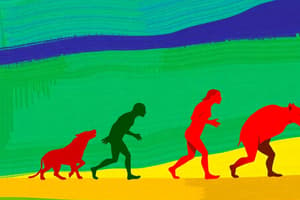Podcast
Questions and Answers
Which of the following is NOT a main component of Lamarck's theory of evolution?
Which of the following is NOT a main component of Lamarck's theory of evolution?
- Theory of Need
- Theory of Natural Selection (correct)
- Theory of Use and Disuse
- Theory of Acquired Characteristics
Lamarck believed that organisms could inherit traits acquired during their lifetime.
Lamarck believed that organisms could inherit traits acquired during their lifetime.
True (A)
What did Darwin observe in the Galapagos Islands that supported his theory of evolution?
What did Darwin observe in the Galapagos Islands that supported his theory of evolution?
Different finch species had different beak structures adapted for different food sources.
The theory of evolution by natural selection is also known as the ______ theory.
The theory of evolution by natural selection is also known as the ______ theory.
Match the following scientists with their corresponding theory of evolution:
Match the following scientists with their corresponding theory of evolution:
Darwin's theory of evolution is based on the idea that organisms adapt instantly to changes in their environment.
Darwin's theory of evolution is based on the idea that organisms adapt instantly to changes in their environment.
What is the meaning of the phrase 'survival of the fittest' in the context of Darwin's theory?
What is the meaning of the phrase 'survival of the fittest' in the context of Darwin's theory?
According to Lamarck's theory, organs that are not used will ______ over time.
According to Lamarck's theory, organs that are not used will ______ over time.
Which of the following is a key difference between Lamarck's and Darwin's theories?
Which of the following is a key difference between Lamarck's and Darwin's theories?
Lamarck's theory of evolution has been widely accepted and supported by modern scientific evidence.
Lamarck's theory of evolution has been widely accepted and supported by modern scientific evidence.
Flashcards
Lamarck's Theory
Lamarck's Theory
Proposed that organisms change based on their needs and use of organs.
Theory of Need
Theory of Need
States that organisms change in response to environmental pressures.
Theory of Use and Disuse
Theory of Use and Disuse
Describes how unused organs disappear while used ones develop.
Theory of Acquired Characteristics
Theory of Acquired Characteristics
Signup and view all the flashcards
Darwinian Theory
Darwinian Theory
Signup and view all the flashcards
Natural Selection
Natural Selection
Signup and view all the flashcards
Survival of the Fittest
Survival of the Fittest
Signup and view all the flashcards
Giraffe Neck Evolution
Giraffe Neck Evolution
Signup and view all the flashcards
Rejection of Lamarck's Theories
Rejection of Lamarck's Theories
Signup and view all the flashcards
Darwin's Observation
Darwin's Observation
Signup and view all the flashcards
Study Notes
Evolution Theories
- Evolution is the change in heritable characteristics of biological populations over successive generations.
- The image shows a visual representation of different stages in human evolution, depicting changes in physical characteristics and skeletal structures over time.
- This illustrates the concept of evolution, emphasizing morphological changes across generations.
Lamarck's Theory
- Jean-Baptiste de Lamarck proposed the first significant evolutionary theory.
- His theory asserted that organisms evolve in response to their environment, adapting and changing themselves over time to suit their surroundings.
- Lamarck proposed that acquired characteristics — traits gained during an organism’s lifetime—could be passed down to offspring.
Theory of Need
- This theory emphasizes that organisms adapt to their environments by responding to their fundamental needs.
- For example, a giraffe's neck lengthening is explained by the giraffe's constant stretching to reach higher leaves over generations.
Theory of Use and Disuse
- This theory states that organs actively used by organisms will strengthen and grow over time, while organs not used will weaken and disappear.
- An example of this theory, also focusing on the giraffe's neck, suggests that constant stretching strengthened the neck.
Theory of Acquired Characteristics
- This aspect of Lamarck’s theory postulates that changes acquired during an organism's life, are heritable and passed on to future generations.
- The text elaborates on how this theory suggests that attributes gained throughout the life of an organism are directly transmitted to their offspring.
Critique of Lamarck's Theories
- Modern biologists largely reject the idea that acquired characteristics are inheritable, a significant critique of Lamarck's theories.
- The concept is now understood that genetic modifications are necessary for heritable changes, and acquired characteristics are not directly passed on.
Darwin's Theory of Natural Selection
- Charles Darwin proposed a comprehensive theory of evolution based on natural selection.
- The theory posits that organisms with advantageous traits are more likely to survive and reproduce, passing on those traits to their offspring.
- Darwin's theory, also known as the theory of natural selection, explains how species change over time, based on the concept of "survival of the fittest."
Darwin's Observations in the Galapagos Islands
- Darwin observed finches with different beak shapes adapted to different food sources on various Galapagos Islands.
- These diverse beak structures are clear evidence of adaptation through natural selection.
- This highlights how variations in traits arise within species due to environmental pressures.
Studying That Suits You
Use AI to generate personalized quizzes and flashcards to suit your learning preferences.




